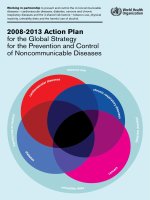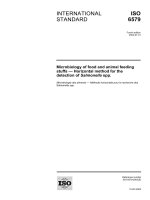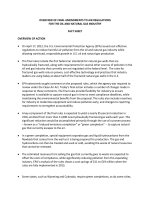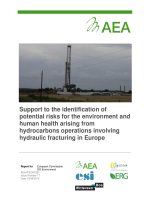Development of Vacuum Assisted Resin Transfer Molding (VARTM) method for the repair and strengthening of concrete structures
Bạn đang xem bản rút gọn của tài liệu. Xem và tải ngay bản đầy đủ của tài liệu tại đây (3.57 MB, 124 trang )
DEVELOPMENT OF VACUUM ASSISTED RESIN TRANSFER MOLDING
(VARTM) METHOD FOR THE REPAIR AND STRENGTHENING
OF CONCRETE STRUCTURES
by
LUIS P. RAMOS
NASIM UDDIN, COMMITTEE CHAIR
ASHRAF AL-HAMDAN
JASON KIRBY
TALAT SALAMA
CHRISTOPHER WALDRON
A DISSERTATION
Submitted to the graduate faculty of The University of Alabama at Birmingham,
in partial fulfillment of the requirements for the degree of
Doctor of Philosophy
BIRMINGHAM, ALABAMA
2013
UMI Number: 3561309
All rights reserved
INFORMATION TO ALL USERS
The quality of this reproduction is dependent upon the quality of the copy submitted.
In the unlikely event that the author did not send a complete manuscript
and there are missing pages, these will be noted. Also, if material had to be removed,
a note will indicate the deletion.
UMI 3561309
Published by ProQuest LLC (2013). Copyright in the Dissertation held by the Author.
Microform Edition © ProQuest LLC.
All rights reserved. This work is protected against
unauthorized copying under Title 17, United States Code
ProQuest LLC.
789 East Eisenhower Parkway
P.O. Box 1346
Ann Arbor, MI 48106 - 1346
DEVELOPMENT OF VACUUM ASSISTED RESIN TRANSFER MOLDING
(VARTM) METHOD FOR THE REPAIR AND STRENGTHENING
OF CONCRETE STRUCTURES
LUIS P. RAMOS
DEPARTMENT OF CIVIL, CONSTRUCTION &
ENVIRONMENTAL ENGINEERING
ABSTRACT
Resin infusion, a method of fabricating fiber reinforced polymer (FRP), has been
shown to produce a stronger FRP of more consistent quality than other methods. It is a
preferred method of fabrication in industries like automotive, aerospace, and boat building. In infrastructure, however, FRP is commonly applied by the hand layup method.
Hand layup is known to produce FRP of questionable quality.
Vacuum Assisted Resin Transfer Molding (VARTM), a form of resin infusion,
can be used to apply externally bonded FRP to infrastructure to increase structural capacity. Based on experience and knowledge in other industries, VARTM is expected to
produce a better FRP than that currently used in infrastructure. This body of work aims
to facilitate the transfer of a proven technology for the benefit of this industry.
Lack of knowledge about VARTM in infrastructure is an impediment to the adoption of an application method which could produce a better final product. This research
sets out to determine VARTM’s benefits or drawbacks compared to hand layup for infra-
iii
structure applications. Shear and flexural ultimate strength and ultimate strain are tested
and compared to verify the assumption that VARTM can produce a better FRP.
Gap analysis, including that of the American Concrete Institute (ACI) 440R, has
identified FRP durability as one of the main areas where further research is needed for
externally bonded FRP. This research does a thorough analysis of the performance of
both VARTM and hand layup FRP durability. Temperature and humidity have been
identified as the principal drivers of environmental degradation. Accelerated conditioning protocols (ACP) for both temperature extremes are applied.
Having analyzed VARTM FRP strength and durability, this research will also test
a modification to improve the VARTM application process on concrete structures.
Grooves sawed into concrete are believed to be able to accelerate the VARTM application time without diminishing the capacity of the final product. Both of these assumptions are tested and verified.
Having proven VARTM performance and having found a way to improve the
original application process, it is hoped that this research has facilitated the implementation of VARTM FRP.
Keywords: VARTM, hand layup, epoxy, carbon fiber, FRP, CFRP, repair, rehabilitation,
strengthening, durability.
iv
ACKNOWLEDGEMENTS
I would like to offer a special thanks to my advisor and project principal investigator, Dr. Nasim Uddin, for being a source of support, advice, encouragement, and
knowledge. His mentorship is appreciated.
I would like to thank the project co-principal investigator, Dr. Uday Vaidya and
Dr. Haibin Ning for efforts to guide the project and educate me about composites.
I would like to thank Dr. Chritopher Waldron and Dr. Talat Salama for teaching
and guiding me; and Dr. Jason Kirby and Dr. Ashraf Al-Hamdan for their good advice.
I would also like to thank the project co-investigator and past author Stephen
Cauthen, who set me up for success by laying the foundation of this project.
Finally, I would like to thank my fellow graduate students; Malcolm Parrish, Li
Dong, Mohammed Mousa, and Heather Riemersma without whom I could not have completed the laboratory testing and publications necessary to complete this project.
v
TABLE OF CONTENTS
Page
ABSTRACT ....................................................................................................................... iii
ACKNOWLEDGEMENTS .................................................................................................v
LIST OF TABLES ............................................................................................................. ix
LIST OF FIGURES .............................................................................................................x
LIST OF ABBREVIATIONS .......................................................................................... xiii
INTRODUCTION ...............................................................................................................1
Need for Rehabilitation ............................................................................................1
Why Use of FRP over Traditional Materials? .........................................................1
VARTM Compared to Hand Layup ........................................................................2
The Importance of Resin Application ......................................................................3
State of the Art of FRP.............................................................................................4
Research Objectives .................................................................................................5
Manuscript Organization .........................................................................................5
STRENGTHENING OF RC BEAMS WITH FRP APPLIED BY VACUUM ASSISTED
RESIN TRANSFER MOLDING (VARTM).......................................................................8
Abstract ....................................................................................................................9
Introduction ............................................................................................................10
Materials and Specimens .......................................................................................12
FRP Application.....................................................................................................15
Test Program ..........................................................................................................16
Test Results ............................................................................................................17
Flexural Beam Test Result Interpretation ..............................................................19
Shear Beam Test Result Interpretation ..................................................................22
Conclusions ............................................................................................................25
Acknowledgments..................................................................................................26
References ..............................................................................................................27
vi
BENEFITS OF GROOVING ON VACUUM ASSISTED RESIN TRANSFER
MOLDING (VARTM) FRP WET-OUT OF RC BEAMS ................................................31
Abstract ..................................................................................................................32
Introduction ............................................................................................................33
Materials and Specimens .......................................................................................36
VARTM Application Method ................................................................................38
Test Program ..........................................................................................................39
Results and Discussion ..........................................................................................41
Conclusions ............................................................................................................45
Acknowledgements ................................................................................................46
Notation..................................................................................................................46
References ..............................................................................................................47
BENEFITS OF GROOVING ON VACUUM ASSISTED RESIN TRANSFER
MOLDING (VARTM) FRP STRENGTHENING OF RC BEAMS .................................51
Abstract ..................................................................................................................51
Introduction ............................................................................................................53
Materials and Specimens .......................................................................................57
VARTM Application Method ................................................................................59
Test Program ..........................................................................................................60
Results and Discussion ..........................................................................................62
Conclusions ............................................................................................................67
Acknowledgements and Role of the Funding Source ............................................68
References ..............................................................................................................69
DURABILITY OF VACUUM ASSISTED RESIN TRANSFER MOLDING (VARTM)
FRP ON CONCRETE PRISMS ........................................................................................72
Abstract ..................................................................................................................73
Introduction ............................................................................................................74
Materials and Specimens .......................................................................................77
Application Methods ..............................................................................................79
Test Program ..........................................................................................................81
Results and Discussion ..........................................................................................85
Conclusions ............................................................................................................89
Acknowledgements ................................................................................................90
References ..............................................................................................................91
CONCLUSIONS................................................................................................................97
ACKNOWLEDGEMENTS .............................................................................................101
vii
REFERENCES ................................................................................................................103
APPENDIX A ..................................................................................................................110
viii
LIST OF TABLES
Table
Page
STRENGTHENING OF RC BEAMS WITH FRP APPLIED BY VACUUM
ASSISTED RESIN TRANSFER MOLDING (VARTM)
1
Summary of Flexural Beam Capacities .................................................... 18
2
Summary of Shear Beam Capacities......................................................... 19
BENEFITS OF GROOVING ON VACUUM ASSISTED RESIN TRANSFER
MOLDING (VARTM) FRP WET-OUT OF RC BEAMS
1
Estimated Range of True Average Time for 95% Wet-Out ..................... 44
BENEFITS OF GROOVING ON VACUUM ASSISTED RESIN TRANSFER
MOLDING (VARTM) FRP STRENGTHENING OF RC BEAMS
1
Summary of Theoretical and Actual Capacities ....................................... 67
2
Estimated Range of True Average Ultimate Strengths ............................. 67
DURABILITY OF VACUUM ASSISTED RESIN TRANSFER MOLDING
(VARTM) FRP ON CONCRETE PRISMS
1
Material Properties .................................................................................... 78
2
Residual Mechanical Properties ................................................................ 89
ix
LIST OF FIGURES
Figure
Page
STRENGTHENING OF RC BEAMS WITH FRP APPLIED BY VACUUM
ASSISTED RESIN TRANSFER MOLDING (VARTM)
1
Flexural Beam Section .......................................................................................... 13
2
Shear Beam Section .............................................................................................. 13
3
Flexural Beam FRP (Bottom Face)....................................................................... 14
4
Shear Beam FRP (Side) ........................................................................................ 14
5
VARTM Method Configuration ........................................................................... 16
6
Beam Support and Load Configuration ................................................................ 16
7
Flexural Beam Load vs. Deflection, Best-fit Line ................................................ 18
8
Shear Beams, Load vs. Deflection, Best-fit Line.................................................. 19
9
Flexural Control Beam .......................................................................................... 20
10 Flexural Hand Layup Beam .................................................................................. 21
11 Flexural VARTM Beam ....................................................................................... 22
12 Shear Control Beam .............................................................................................. 23
13 Shear Hand Layup Beam ...................................................................................... 24
14 Shear VARTM Beam ............................................................................................ 25
BENEFITS OF GROOVING ON VACUUM ASSISTED RESIN TRANSFER
MOLDING (VARTM) FRP WET-OUT OF RC BEAMS
1
Beam Dimensions ................................................................................................. 37
x
2
Groove Dimensions .............................................................................................. 37
3
VARTM Method Configuration ........................................................................... 38
4
VARTM, Beam 1 with 3.2 mm Grooves, 30 sec .................................................. 40
5
VARTM, Beam 1 with 3.2 mm Grooves, 60 sec .................................................. 40
6
VARTM, Beam 1 with 3.2 mm Grooves, 90 sec .................................................. 40
7
VARTM, Beam 1 with 3.2 mm Grooves, 120 sec ................................................ 41
8
Time vs. Wet-Out for Beams with 3.2 mm Grooves ............................................ 42
9
VARTM, Beam 2 with 6.4 mm Grooves, 342 sec ................................................ 42
10 Time vs. Wet-Out for Beams with 6.4 mm Grooves ............................................ 43
11 Time vs. Wet-Out for Beams without Grooves .................................................... 44
BENEFITS OF GROOVING ON VACUUM ASSISTED RESIN TRANSFER
MOLD-ING (VARTM) FRP STRENGTHENING OF RC BEAMS
1
Wet Out vs Time of Beams with and without Grooves (Ramos, et al. [18]) ........ 56
2
Beam Dimensions ................................................................................................. 59
3
Groove Dimensions .............................................................................................. 59
4
VARTM Method Configuration ........................................................................... 60
5
Loading Configuration .......................................................................................... 61
6
Strain Gauge Configuration .................................................................................. 62
7
254 mm Deep Beams ............................................................................................ 64
8
254 mm Deep Beam, B2, No Grooves, after Failure ............................................ 64
9
279 mm Deep Beams ............................................................................................ 66
10 279 mm Deep Beam, B1, No Grooves, after Failure ............................................ 66
xi
DURABILITY OF VACUUM ASSISTED RESIN TRANSFER MOLDING (VARTM)
FRP ON CONCRETE PRISMS
1
Specimen Elevation .............................................................................................. 78
2
Specimen Section .................................................................................................. 79
3
VARTM Configuration ......................................................................................... 80
4
Strain Gage Placement .......................................................................................... 83
5
Strength Test Configuration .................................................................................. 84
6
Strength Test - Deflectometer ............................................................................... 85
7
Strength Test - Typical Break ............................................................................... 86
8
Freeze-Thaw Specimen Load Tests ...................................................................... 88
9
Hygrothermal Specimen Load Tests ..................................................................... 88
xii
LIST OF ABBREVIATIONS
ACI
American Concrete Institute
ACP
accelerated conditioning protocol
ALDOT
Alabama Department of Transportation
ASCE
American Society of Civil Engineers
ASTM
American Society for Testing and Materials
CSP
concrete surface profile
CTE
coefficient of thermal expansion
DOT
Department of Transportation
FEM
finite element method
FHWA
Federal Highway Administration
FRP
fiber reinforced polymer
IC
intermediate crack
ICRI
International Concrete Repair Institute
NCHRP
National Cooperative Highway Research Program
PT
prestressing steel
RC
reinforced concrete
VARTM
vacuum assisted resin transfer molding
VOC
volatile organic compound
W/C
water to cement ratio
xiii
INTRODUCTION
Need for Rehabilitation
Infrastructure in the United States (US) is aging, making the need to improve the
methods of bridge repair and rehabilitation a priority. According to the American Society
of Civil Engineers (ASCE), the average age of bridges in this country is 43 years and
most were designed to last 50 years (ASCE 2009). ASCE estimates that we will have
$930 billion of infrastructure investment needs over the next five years, but estimates that
only $380.5 billion will be available as funds (ASCE 2009). The age of bridges in the
US and lack of funds make the strength of repairs and their durability important considerations when considering the benefit and life cycle cost of a repair.
This demand has led to a recent rapid growth in use of externally applied fiber reinforced polymer (FRP) for bridge repair and rehabilitation. The number of projects
worldwide using externally bonded FRP has grown from a few in the mid 1980’s to thousands in 2008 (ACI 2008).
Why Use of FRP over Traditional Materials?
FRP stands out over traditional materials for its high strength-to-weight ratio.
Many traditional methods of rehabilitation use steel or concrete, which add weight and
reduce the net gain in capacity of the structure. Weight is especially critical in seismic
areas, where additional mass causes greater damage to a structure during a seismic event.
1
The traditional methods that add the most weight tend to be the least expensive. Project
priorities must be evaluated individually.
There are many methods used to rehabilitate bridges, including the attachment of
steel plates, enlargement of the current section with concrete, addition of external prestressing (PT) stressed by post-tensioning, and drilling in of additional steel reinforcement. Traditional methods have the benefit of using materials that are common in the
construction industry and can be applied by well-known means. One drawback of these
methods is that they tend to require heavy construction equipment. Equipment can cause
closures of lanes on or below a bridge and access to some areas can be difficult.
VARTM Compared to Hand Layup
Despite increasing adoption, little has been done to improve the FRP application
process. FRP in infrastructure is commonly applied by the hand layup method. Hand
layup is labor intensive and the quality of the final product is sensitive to environmental
conditions and the skill of the installer. Hand layup may be cost effective and easy to apply, but it creates an FRP that is variable and could contain defects (Delaney 2006).
Hand layup makes it difficult to achieve a uniform wet-out free of pools or voids and a
good fiber compaction without excessive wrinkling (Karbhari 2001).
VARTM is a novel method, relatively unknown in infrastructure rehabilitation.
VARTM shows promise because it eliminates many of the variables that diminish the
quality of hand layup FRP. Resin infusion is capable of achieving uniformity, good fab-
2
ric compaction, and less unintended deformation (Karbhari 2001).
While neither pro-
cess is foolproof, resin infusion is more consistent.
The Importance of Resin Application
The key difference in VARTM and hand layup is in how the resin is applied and
how that will affect the final product. There is a general agreement that resin application
is an important factor for the strength and durability of FRP. It is critical that an appropriate thickness of resin-rich surface exist (Karbhari 2003) because the resin serves as a
protective layer (ACI 2012). It protects the FRP and may also protect the concrete underneath (Cromwell, et al. 2011). Resin application is also paramount to the FRP bond to
concrete, which is a limiting factor in FRP strength.
Hand layup has been found to result in an inconsistent application of resin. Hand
layup inherently bears the potential for non-uniform wet-out of the fabric (Karbhari
2001). Recent tests found that specimens created by hand layup were not uniform and
produced test results with a high standard deviation (Li, et al. 2012). During the fabrication of hand layup specimens for these tests, resin-rich areas, bubbles, and other inconsistencies are observed. Correcting these defects holds the risk of wrinkling the fiber,
which creates a weakness.
Resin infusion, on the other hand, is capable of achieving uniformity, good fabric
compaction, and less unintended deformation (Karbhari 2001). VARTM has been investigated and found to develop a more homogenous interface (Uddin 2008). During the
fabrication of VARTM specimens for these tests, the resin is observed creating a thor3
ough resin-to-filament bond without disturbing the fabric. Bubbles are pulled from the
FRP by the vacuum before the resin sets. The wet-out quality that VARTM can achieve
could give FRP greater strength and a more consistent protective surface.
A recent study demonstrates that preformed FRP has a clear advantage over hand
layup FRP in durability (Cromwell, et al. 2011). Cromwell points out that manufactured
materials had the advantage of quality control over hand layup and the advantage of
manufactured materials should not be surprising. Preformed FRP can be difficult to conform to girders in the field; especially around sectional transitions, diaphragms, inserts,
and other irregularities. Because of this drawback, preformed laminates are not considered for these tests. VARTM may have the inherent advantage of a manufactured product with the flexibility of application.
State of the Art of FRP
Research on externally bonded fiber reinforced polymer (FRP) has matured, leading to state-of-the-art reports from the American Concrete Institute (ACI 2007) and
guides for design and construction from (ACI 2008) and the National Cooperative Highway Research Program (NCHRP) (Mirmiran, et al. 2004 and 2008; Zureick, et al. 2010;
Belarbi, et al. 2011). Despite the growing body of knowledge, there are still gaps in our
understanding of FRP. FRP durability and the refinement of FRP fabrication methods
have been identified as research needs for FRP used in infrastructure (Porter 2007).
4
Research Objectives
The objectives of this work are to respond to the needs identified in gap analysis,
to shed light on FRP durability, and to improve the FRP application process. To satisfy
the first need identified by gap analysis, this research tests the durability of VARTM
specimens and hand layup specimens at both temperature extremes and compares the results of the two methods of application. To meet the second need identified, an improvement to the VARTM process will be tested. It is believed that grooving may improve the speed of VARTM application and the strength of the final product. Both of
these possibilities will be tested.
Porter (2007) believes that research aimed at establishing uniform quality control
for external FRP systems have a great likelihood of high return. Previous researchers
have seen improvements to FRP quality from resin transfer application. The broader objective of this research, by closing gaps in knowledge about it and improving its application process, is to facilitate the adoption and implementation of a method of application
which has been shown to produce an FRP of more consistent quality.
Manuscript Organization
The research conducted to meet the objectives stated above has produced technical papers which were submitted for publication in leading journals of civil engineering. The work is divided into four technical papers.
The first manuscript is an investigation of the strength gains of RC beams from
externally bonded FRP applied by VARTM. Two types of RC beams are used; one de5
signed to fail in shear and the other in flexure. One VARTM FRP, one hand layup FRP,
and one control sample without FRP of each beam type are tested. Four-point load testing is used to determine ultimate load capacity and deflection. This technical note has
been submitted to the Journal of Composites for Construction, an ASCE publication.
The second manuscript investigates the reduction of VARTM wet-out time
achieved by sawing grooves into the concrete surface. FRP U-jackets are applied by
VARTM to beams with vertical grooves. The wet-out of the beams is recorded and
timed. This manuscript has been accepted for publication in the Journal of Composites
for Construction, an ASCE publication.
The third manuscript is a follow-up to the second manuscript. The previous research shows that VARTM’s application time can be reduced by cutting vertical grooves
into the concrete surface to accelerate wet-out. The objective of this research is to determine if the grooves are a benefit or detriment to the ultimate strength of the beams. The
VARTM method is used to apply FRP U-jackets to beams with vertical grooves. Beams
are tested, half designed to fail in shear and the other half designed to fail in flexure. This
manuscript has been submitted to Composite Structures, an Elsevier publication.
The fourth manuscript evaluates the durability of FRP created by VARTM and
hand layup methods. Prisms wrapped in a single sheet of FRP are conditioned by freezethaw cycling, while others are exposed to hygrothermal conditions combining high heat
and humidity. Half of the specimens are fabricated by VARTM and the other half by
hand layup. The ultimate strength and strain of specimens after conditioning is compared
6
to that of control specimens. This technical paper has been submitted to the Journal of
Composites for Construction, an ASCE publication.
7
STRENGTHENING OF RC BEAMS WITH FRP APPLIED BY VACUUM ASSISTED
RESIN TRANSFER MOLDING (VARTM)
LUIS RAMOS, NASIM UDDIN, STEPHEN CAUTHEN AND UDDAY VAIDYA
Submitted to Journal of Composites for Construction (ASCE)
Format adapted for dissertation
8
Abstract
Fiber reinforced polymer (FRP) externally bonded to reinforced concrete (RC)
beams is commonly applied by hand layup, which produces FRP of inconsistent quality
and uniformity. Vacuum Assisted Resin Transfer Molding (VARTM), a novel application method in infrastructure, can achieve a more consistent FRP. The purpose of this
research is to investigate the strength gains of RC beams from externally bonded FRP
applied by VARTM. Two types of RC beams are used, one designed to fail in shear and
the other in flexure. One VARTM FRP, one hand layup FRP, and one control sample
without FRP of each beam type are tested. Four-point load testing is used to determine
ultimate load capacity and deflection. Beams in these tests wrapped with VARTM FRP
have 19% more ultimate flexural capacity and 10% more ultimate shear capacity than
beams in these tests using hand layup FRP. VARTM beams also exhibit slightly higher
ductility in flexure. These capacity and ductility results are likely due to an FRP with
high fiber volume ratio, which VARTM is known to produce.
9
CE Database Subject Headings - Concrete beams; fiber reinforced polymer; vacuum;
flexural strength; shear strength.
Introduction
The demand for fiber reinforced polymer (FRP) bridge rehabilitation is high because many bridges in the United States are in poor condition. 21.9% of bridges in the
National Highway System were deficient in 2009 (FHWA 2010). The number of projects
using externally bonded FRP worldwide has grown from a few in the mid 1980’s to thousands in 2008 (ACI 2008). Research on externally bonded FRP has matured leading to
state-of-the-art reports (ACI 2007) and guides for design and construction from ACI
(ACI 2008) and NCHRP (Mirmiran 2004 and 2008; Zureick 2010; Belarbi 2011). The
demand for rehabilitation, growing project experience, and new standards will further the
adoption of externally bonded FRP.
Despite increasing adoption, little has been done to improve the FRP application
process. Hand layup is the most common method of application. Hand layup may be
cost effective and easy to apply, but it creates an FRP that is variable and could contain
defects (Delaney 2006). Delaney (2006) also found that failure modes were influenced
by minor variations in wet layup application techniques. Hand layup makes it difficult to
achieve a uniform wet-out free of pools or voids and a good fiber compaction without
excessive wrinkling (Karbhari 2001). Resin infusion is capable of achieving uniformity,
good fabric compaction, and less unintended deformation (Karbhari 2001).
ther process is foolproof, resin infusion is more consistent.
10
While nei-
Some hand layup quality control issues, like fiber alignment variation, can be addressed by using preformed laminate FRP. But some benefits common to hand layup and
VARTM, like conforming to complicated shapes, are lost. Therefore, preformed laminates will not be tested.
Resin quantity affects material costs, flexural cracking, and stiffness. Hand layup
produces FRP with up to 30% fiber by weight, while VARTM typically produces FRP
with 60% fiber by weight (JHM 2011). VARTM reduces the quantity of resin needed,
and that has a minor impact on material costs. Although the resin cost is small in portion
to the total cost of the FRP, any reduction in cost is desirable. Poorly reinforced FRP
(too much resin/not enough fiber) is prone to cracking if flexed (JHM 2011). The additional resin may also cause a minimal, albeit undesirable increase in stiffness/decrease in
ductility.
Despite the benefits of VARTM, the additional steps (pump operation and installation of additional layers) lengthen application time and increase labor costs. Additional
costs may limit adoption, but VARTM may be the best choice for a project that requires
FRP with higher strength and reliability.
The feasibility of vacuum curing (Stallings 2000) and VARTM (Uddin 2004; Serrano-Perez 2005) has been demonstrated in the field.
VARTM bond strength was inves-
tigated and found to develop a more homogenous interface (Uddin 2008).
The objective of this research is to examine the performance of a VARTM FRP
beam and compare it to the performance of a hand layup FRP beam and a control beam
without FRP. The performance of beams in shear and flexure will be tested. Failure
11
mechanisms will be examined. Findings will be evaluated to determine whether the advantages expected from the VARTM method are produced.
Materials and Specimens
Reinforced concrete beams are fabricated using 27.6 MPa concrete and 414 MPa
steel reinforcement. Each beam is 2.74 meters long and approximately a year old at time
of testing. Two types of beams are being tested. Flexural beams (Figure 1) are designed
to fail in flexure. Shear beams (Figure 2) have stirrups at 305 mm spacing to force a
shear failure. This exceeds the maximum spacing in ACI of half the beam depth (ACI
2008). Test samples will be evaluated to determine if shear cracks engaged stirrups.
Stirrups spacing is constant along the length of the beam for both flexural and shear
beams. Three flexural and three shear beams are tested; each with one VARTM FRP,
one hand layup FRP, and one control.
12









